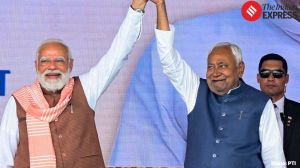Stay updated with the latest - Click here to follow us on Instagram
Keeping the pulse count,as the clock ticks
As the marathon day fast approaches Mumbais pulse is racing fast. But ask any coach about this and they wouldnt want their wards to be in the same mood.
As D-Day approaches,coaches give last minute instructions to amateur runners
As the marathon day fast approaches Mumbais pulse is racing fast. But ask any coach about this and they wouldnt want their wards to be in the same mood. With their eyes on the heart-beat count,they dont want high readings before the 42.125 kms Sunday.
And thats the reason coach Praful Uchil,who has been training 40 amateur runners for a year now to turn them into marathoners,checks the pulse before he starts training at the Mahalaxmi Race Course. Its a must since we had strenuous training yesterday. I ask them to monitor their pulse rate over ten seconds even before they get out of their beds in the morning. And then accordingly,I decide their particular days workout, says the 38-year-old former athlete.
Uchil informs that the pulse rate of ten seconds is then multiplied by six and the sum becomes the basis of that particular days training. If someones pulse rate is higher than 60 beat per minutes,it means the body has not recovered. Then we have to keep the workout light for him, says the employee of Life Corporation of India.
Uchil,who had started Striders with co-trainer Deepak Londhe four years ago,now has three more trainers assisting him. Not only have the numbers of enthusiasts gone up,the seriousness about running has also become high. That forced us to start the year long training, informed Uchil.
However,trainers have to keep a close watch on different persons ability to decide what amount of work one can go through. It is pretty simple, says Uchil. We subtract ones age from a heart beat of 220 per minute. The sum that we get is the amount of vigorous training one can go through within a minute, informs Uchil.
But the trainer says that it is tough to get amateur runners who stay motivated for the entire year. But the runners that Londhe fears the most are the late-risers. We do get people coming in as late as 15 days before the marathon. These are the people get tempted to run the marathon after the hysteria starts building up, added the 31-year-old NIS certified coach. When we try to give them light workouts,they arent satisfied. Some even doubt our ability. They demand to do more efforts at a go as if they want to get marathon compatibility within a day, says the coach who had worked with senior national athletics team as a triple jump instructor.
The one thing that marathon enthusiasts love about training is the diet chart before the D-Day. We dont asked them to put any restriction on food since it is not a threat for these people as the calories burn fast during practice and the fat doesnt accumulate, says Uchil. We asked them to eat as much carbohydrate they can it in the form of rice and chappatis, says Uchil. In fact as the race inches closure,we ask them to eat more carbohydrates as it is a good source of energy when one needs it for immediate running, added Uchil.







